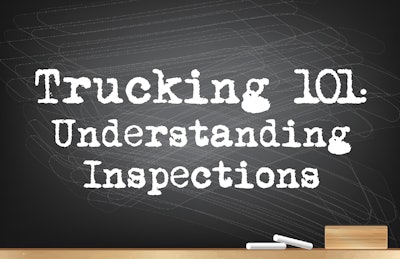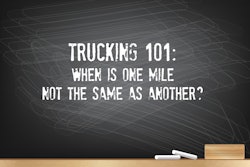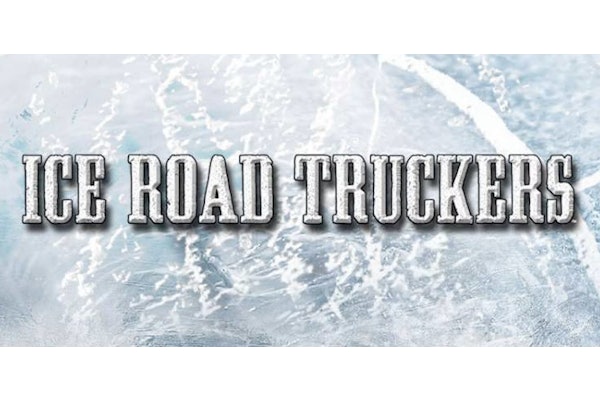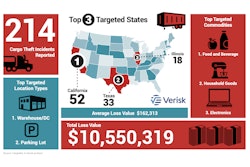
With some 4 million commercial vehicles being inspected on North American highways during the course of a year -- including several special concentrated inspection efforts conducted by law enforcement -- it's a pretty good chance that you will eventually be stopped.

The Commercial Vehicle Safety Alliance is an organization of safety officials and members of the trucking industry members who work to improve highway safety. It also organizes several inspection efforts each year and educates law enforcement agents and members of the trucking industry on the various types of inspections.
It also provides informational materials about its inspection program, including:
- Understanding the North American Standard Inspection Program
- North American Roadside Inspection Vehicle Cheat Sheet
- State Mandated Inspection Programs
Here's how the CVSA explains each level of inspection:
Level I – North American Standard Inspection
This 37-step inspection includes an examination of the driver’s license; Medical Examiner’s Certificate and Skill Performance Evaluation (SPE) Certificate (if applicable); alcohol and drugs; driver’s record of duty status, as required; hours of service; seat belt; vehicle inspection report(s) (if applicable); brake systems; cargo securement; coupling devices; driveline/driveshaft; exhaust systems; frames; fuel systems; lighting devices (headlamps, tail lamps, stop lamps, turn signals and lamps/flags on projecting loads); steering mechanisms; suspensions; tires; van and open-top trailer bodies; wheels, rims and hubs; windshield wipers; buses, motor coaches, passenger vans or other passenger-carrying vehicles – emergency exits, electrical cables and systems in engine and battery compartments, seating, hazardous materials or dangerous good (HM/DG) and specification cargo tank requirements, as applicable. HM/DG required inspection items will only be inspected by certified HM/DG and cargo tank inspectors, as applicable.
Level II – Walk-Around Driver/Vehicle Inspection
 CVSA
CVSA
Level III – Driver/Credential/Administrative Inspection
This examination includes, where required and/or applicable: an examination of the driver’s license; Medical Examiner’s Certificate and Skill Performance Evaluation (SPE) Certificate; driver’s record of duty status; hours of service; seat belt; vehicle inspection report(s); and carrier identification and status. Mechanical equipment violations specific to a Level I or Level II Inspection should not be included in a Level III Inspection. If applicable, traffic violations/infractions should be included on a Level III Inspection.
Level IV – Special Inspections
Inspections under this heading typically include a one-time examination of a particular item. These examinations are normally made in support of a study or to verify or refute a suspected trend.
Level V – Vehicle-Only Inspection
This inspection includes each of the vehicle inspection items specified under the North American Standard Inspection (Level I), without a driver present, conducted at any location.
Level VI – North American Standard Inspection for Transuranic Waste and Highway Route Controlled Quantities (HRCQ) of Radioactive Material
This is an inspection for select radiological shipments, which include inspection procedures, enhancements to the North American Standard Level I Inspection, radiological requirements and the North American Standard Out-of-Service Criteria for Transuranic Waste and Highway Route Controlled Quantities of Radioactive material.
As of Jan. 1, 2005, all vehicles and carriers transporting HRCQ of radioactive material are regulated by the U.S. Department of Transportation (DOT) and required to pass the North American Standard Level VI Inspection.
Previously, U.S. Department of Energy (DOE) voluntarily complied with the North American Standard Level VI Inspection Program requirements.
Select radiological shipments include HRCQ of radioactive material as defined by Title 49 CFR 173.403. And, because only a small fraction of transuranics are HRCQ, the U.S. DOE decided to include its transuranic waste shipments in the North American Standard Level VI Inspection Program.
Level VII – Jurisdictional Mandated Commercial Vehicle Inspection
This is an inspection that is a jurisdictional-mandated inspection program that does not meet the requirements of any other level of inspection. An example will include inspection programs such as, but not limited to, school buses, limousines, taxis, shared-ride transportation, hotel courtesy shuttles and other intrastate/intra-provincial operations. These inspections may be conducted by CVSA-certified inspectors, other designated government employees or jurisdiction-approved contractors. Inspector training requirements shall be determined by each jurisdiction. No CVSA decal shall be issued for a Level VII Inspection but a jurisdiction-specific decal may be applied.
Level VIII – North American Standard Electronic Inspection
This electronic inspection must include, where required and/or applicable, a descriptive location, including GPS coordinates; electronic validation of who is operating the vehicle; appropriate driver’s license class and endorsement(s) for vehicle being operated; license status; valid Medical Examiner’s Certificate and Skill Performance Evaluation (SPE) Certificate; current driver’s record of duty status; hours-of-service compliance; USDOT or (Canada) NSC number; power unit registration; operating authority; Unified Carrier Registration (UCR) compliance; and federal out-of-service orders.
The North American Standard Level VIII Electronic Inspection is an inspection conducted electronically or wirelessly while the vehicle is in motion without direct interaction with an enforcement officer. To be considered a complete Level VIII Electronic Inspection, a data exchange must include each of the required and/or applicable data points listed in the CVSA North American Standard Level VIII Electronic Inspection definition.






![Shutterstock 137842070[88] (1)](https://img.truckersnews.com/files/base/randallreilly/all/image/2021/12/shutterstock_137842070_88___1_.61afbd06e50db.png?auto=format%2Ccompress&fit=crop&h=167&q=70&w=250)




